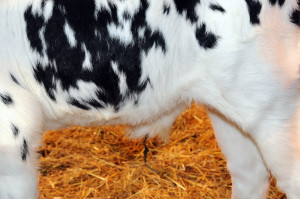Healthy Calf Conference
Follow to stay up-to-date on all Healthy Calf Conference updates. Speaker announcements, sponsorship information, registration announcements, and more.

Umbilical hernias are the most common birth defect in calves. They occur when the umbilical ring fails to close after birth, allowing abdominal contents to protrude through the opening. Umbilical hernias vary in severity from those that will spontaneously heal to those that will need surgical repair. But how do you determine whether it is severe and requires surgery or not? Some of the factors that should be considered when assessing the umbilical hernia include the size of the hernia, whether infection is present, and if the hernia can be reduced (i.e. the abdominal contents can be pushed easily back into place).
The size of an umbilical hernia can differ greatly, based on the size of the opening of the umbilical ring and the amount of abdominal contents that have protruded through this opening. If the hernia is less than one to three cm in diameter, and/or if the contents of the hernia are easily reducible, it is likely that the hernia is not severe and will heal spontaneously. A hernia that is less than four to five cm (or less than three fingers wide) can likely be resolved by wrapping an elastic bandage over the belly to keep the contents in once they have been put back in place. However, the larger the hernia sac, the more likely it is that the umbilical ring opening is large, and increasing the odds of surgical repair becoming necessary. As a rule of thumb, if the hernia sac/opening is more than six cm, can’t be replaced easily into the abdomen, persists for several weeks, and/or is infected, it is considered severe and you should contact your herd veterinarian to have it assessed.
When assessing the size of the hernia, it is also important to check for infection. Some signs of an infected hernia include fever, loss of appetite and poor growth rates. In some cases, signs of infection can also include frequent urination and urination through the umbilicus. If any of these symptoms are present it is important to further investigate the situation by calling your herd veterinarian to determine next steps.
It is also possible for an umbilical hernia to develop into a strangulated hernia. This happens when the intestines, which are part of the abdominal contents contained in the hernia sac, become twisted outside the body. Symptoms of a strangulated hernia include a warm, swollen, firm and painful hernia sac accompanied by signs of colic (grinding teeth, grunting, arching back, shifting weight, restlessness, depression, etc.). This type of umbilical hernia requires surgical repair by your herd veterinarian.
It is important to recognize and differentiate the signs and symptoms between a routine umbilical hernia that will heal on its own and a severe or strangulated umbilical hernia requiring surgical repair. If any signs and symptoms pointing towards a severe or strangulated hernia exist, consultation with your herd veterinarian is strongly encouraged to maintain the health and well-being of your calves. When inspecting your calves for umbilical hernias, it is better to be safe than sorry!
This article is part of an educational series project funded in part through Growing Forward 2 (GF2), a federal-provincial-territorial initiative. The Agricultural Adaptation Council assists in the delivery of GF2 in Ontario.

Follow to stay up-to-date on all Healthy Calf Conference updates. Speaker announcements, sponsorship information, registration announcements, and more.
The Codes of Practice are nationally developed guidelines for the care and handling of farm animals. They serve as our national understanding of animal care requirements and recommended practices.